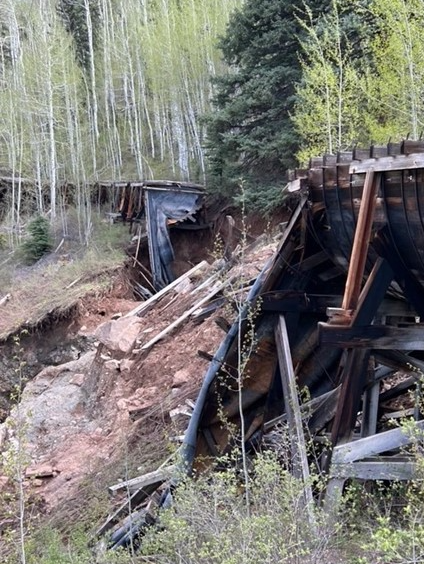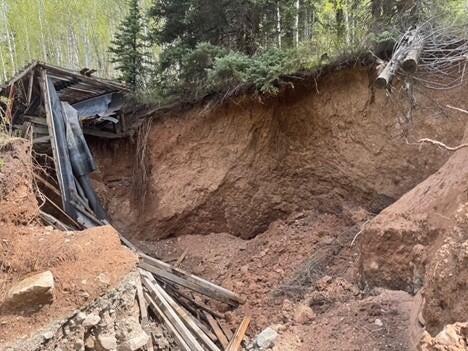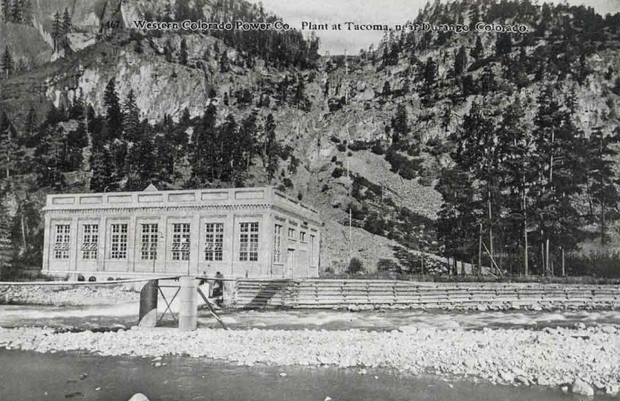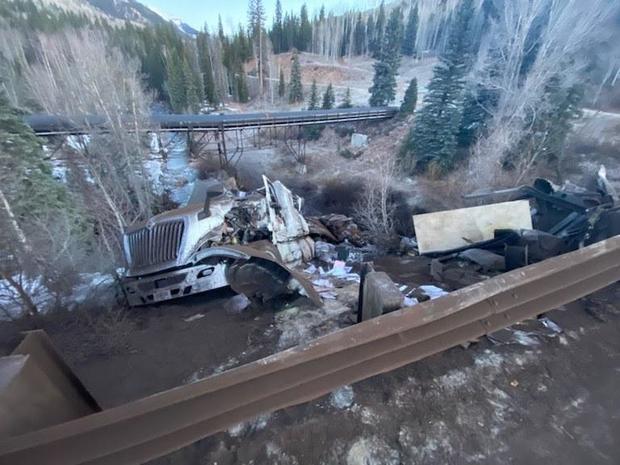Historic Colorado flume collapses, causes landslide
Crews have begun clean-up operations in southwestern Colorado where a 102-year-old wooden flume broke open last month, causing a landslide and forest closure.
The wooden flume follows Cascade Creek west of Cascade Curve on U.S. 550 between Silverton and Durango, about two miles north of the Purgatory ski resort. It is one of only two wooden flumes still operating on hydroelectric projects in the country, according to Xcel Energy.
There is no indication when the actual break occurred, nor whether it began as a small leak that slowly worsened or if it ruptured suddenly. Regardless, water from the damaged flume ripped away part of the steep hillside below it. As a result, more of the support structure for the flume was exposed and failed, increasing the amount of flume which collapsed.
Below the damaged flume, the terrain was "destabilized" and trees fell, according to a social media from the U.S. Forest Service's San Juan office. Support structure for nearby power lines was also threatened.
The forest service closed the area between the flume and the Cascade Creek hiking trail on June 6 for public safety. It has not opened since.
Crews from Xcel and the forest service started working on the damaged area and planning for potential repair during the last week of June.
A final report on the cause of the event is not yet completed, per an Xcel spokesperson.
The flume was first constructed as a box flume starting in 1903. Completed a year later, it was part of a power supply project for mining operations in Silverton and Durango. Water diverted from the upper reaches of Cascade Creek was transported by the flume to Electra Lake, a reservoir that was dammed the next year in 1905. Water from the lake ended its 1,000-foot descent at the Tacoma Power Plant, located along the banks of the Animas River. The hydroelectric plant generated power through gravity-driven water. It delivered power to its first customer - a mine - in early 1906 along newly completed transmission lines.
Water originating from the highest snowpack travels 18 miles to the power plant. After use, it is directed into the Animas River.
"The Tacoma plant produces clean energy," Xcel states online, "there is no water, air or land pollution from the operation."
Throughout its history, the power plant has been accessible only by narrow-gauge train or track car. It was built with construction materials were transported along those tracks. The generators, first intended for use in a power plant near Tacoma, Washington, arrived in crates labeled "Tacoma." Those crates "sat by the railroad siding for several weeks," according to the Animas Museum in Durango. "People started calling the railroad stop Tacoma and the name stuck."
The flume didn't escape that association, either. It has been referred to as both the Cascade Flume and the Tacoma Flume.
The original flume leaked badly, according to records. An upper portion was replaced in 1927-28 by a semi-circular, 10-foot diameter, open-topped design made of creosoted Oregon fir. Its route was adjusted, too. The lower portion of flume, meanwhile, was replaced with segments of buried steel pipeline between 1949 and 1952.
It was a section of the 4,400-foot long upper portion which collapsed in June. Because of the water reserved in Electra Lake, power delivery has not been interrupted. But water flow in Cascade Creek to private properties below the damaged flume has been limited by debris.
The U.S. Forest Service claims the Cascade Flume and Pipeline site is eligible for listing on the National Register of Historic Places. However, it has not been formally nominated and listed. It still meet the definition of a historic property as defined in the National Historic Preservation Act, per a USFS spokesperson.
The approval process to repair the flume will be complex and involve a number of parties, an Xcel spokesperson told CBS Colorado. A meeting is planned this week which will include a number of them, including the Federal Energy Regulation Commission.
Ownership of the flume has changed hands several times over its history. Public Service Company of Colorado, now a subsidiary of Xcel, took it over in 1992. The company has used a combination of employees and outside contractors to maintain the flume.
As stated in the archives of the U.S. Forest Service, "The head works, wooden flume (a portion of which recently collapsed), siphon intake structure, the portion of the siphon crossing Cascade Creek on a bridge and the siphon outlet structure are important visual elements of a functioning historical water delivery system. Although neither the flume nor the siphon was particularly unusual at the time that they were constructed, through attrition they have become an unusual surviving example of historical technology that has often been replaced by more modern conveyances."








